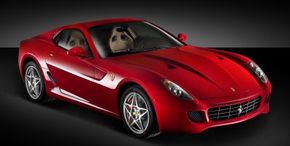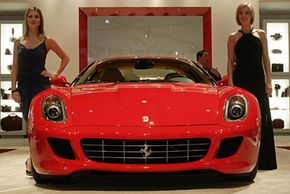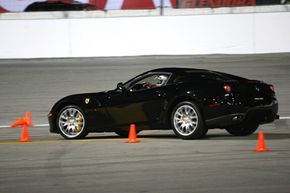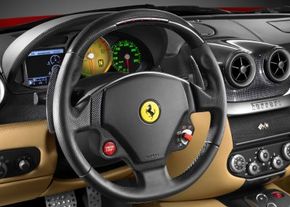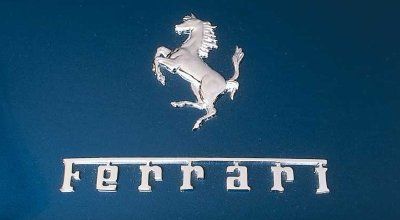Despite such "Speed Racer" accoutrements, the Ferrari 599 GTB Fiorano was every inch the luxurious, all-day comfortable two-seat Ferrari. The cockpit was not only spacious (thanks to the long wheelbase) but beautifully crafted from fine leather, aluminum and carbon fiber. The two contoured seats were power operated, as were the windows, mirrors, door locks, and tilt/telescope steering wheel. Dual-zone automatic climate control was included, as were heated mirrors and keyless entry.
Options were plentiful, needless to say, as Ferrari was now determined to satisfy every possible "client" request. For example, the 599 tested by Road & Track for its May 2007 issue arrived with the worthwhile CCM brakes (at $18,550), plus carbon-fiber door panels and sills ($5790), a leather/CF steering wheel ($5621), heated Recaro seats ($3710), theatre-quality Bose audio ($3260), leather headliner ($439), and the almost obligatory cavallino rampante front-fender emblems ($1743).
With these and other add-ons, the formidable $278,345 base price swelled to an eye-popping $319,408 delivered. Such is the price of excellence born of world-beating competition experience.
And such is the price of world-beating performance available anytime, anywhere you wish. Consider Road & Track's results: 0-60 mph in 3.2 seconds -- "Yes, that's right, quicker than an Enzo" -- 0-100 in seven seconds flat, a standing quarter-mile of 11.2 seconds at 129.3 mph, and 0.97g on the skidpad.
But as always with Ferraris, mere numbers don't begin to tell the story. "The more time you spend in the [Ferrari 599 GTB Fiorano], the more you respect it," R&T enthused. "You can't help but be impressed by a car classified as a GT machine that can perform with the world's best sports cars. And sure, it handles great and looks great. But eventually you realize something: What defines the 599 is that awe-inspiring 611-horsepower V-12; the unreal power to which you never get accustomed, the way it wants to shred the rear tires under full throttle. And the most raucous, intoxicating exhaust note this side of a race car." No wonder the Ferrari 599 GTB Fiorano was instantly acclaimed the world over as one of the all-time great Ferraris.
It was certainly a grand prelude to Ferrari's 60th anniversary year. And happily, its story is just beginning. Those in the know say a Ferrari 599 spider is just around the corner, followed by track racer and perhaps even a new "roto-top" Superamerica version. We can hardly wait.
